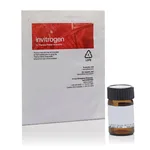
Thermo Fisher Scientific MTCO2 Monoclonal Antibody (12C4F12)
✨AI 추천 연관 상품
AI가 분석한 이 상품과 연관된 추천 상품들을 확인해보세요
연관 상품을 찾고 있습니다...
Applications
Tested Dilution
Publications
Western Blot (WB)
1 µg/mL
View 68 publications 68 publications
Immunohistochemistry (IHC)
-
View 3 publications 3 publications
Immunohistochemistry (Paraffin) (IHC (P))
-
View 1 publication 1 publication
Immunohistochemistry (Frozen) (IHC (F))
-
View 1 publication 1 publication
Immunocytochemistry (ICC/IF)
5-10 µg/mL
View 7 publications 7 publications
Miscellaneous PubMed (Misc)
-
View 6 publications 6 publications
Product Specifications
Species Reactivity
Human
Published species
Chicken, Human, Mouse, Non-human primate, Rat
Host/Isotype
Mouse / IgG2a, kappa
Class
Monoclonal
Type
Antibody
Clone
12C4F12
Immunogen
Full-length native Human Cytochrome C oxidase (Complex IV) subunit II, from SDS-PAGE if (typeof window.$mangular === undefined || !window.$mangular) { window.$mangular = {}; } $mangular.antigenJson = \[{targetFamily:MTCO2,uniProtId:P00403-1,ncbiNodeId:9606,antigenRange:1-227,antigenLength:227,antigenImageFileName:A-6404_MTCO2_P00403-1_House_mouse.svg,antigenImageFileNamePDP:A-6404_MTCO2_P00403-1_House_mouse_PDP.jpeg,sortOrder:1}\]; $mangular.isB2BCMGT = false; $mangular.isEpitopesModalImageMultiSizeEnabled = true;
View immunogen .st0{fill:#FFFFFF;} .st1{fill:#1E8AE7;}
Conjugate
Unconjugated Unconjugated Unconjugated
Form
Liquid
Concentration
1 mg/mL
Purification
IgG fraction
Storage buffer
HEPES buffered saline
Contains
0.02% sodium azide
Storage conditions
4° C, do not freeze
Shipping conditions
Wet ice
RRID
AB_221584
Product Specific Information
To facilitate the study of COX structure and mitochondrial biogenesis, Invitrogen offers several subunit-specific mouse anti-OxPhos Complex IV monoclonal antibodies. The binding specificity of our anti-OxPhos Complex IV monoclonal antibody preparations allows researchers to investigate the regulation, assembly, and orientation of COX subunits in a variety of organisms. The antibodies have also proven valuable for analyzing human mitochondrial myopathies and related disorders as well as mitochondrial DNA depletion due to drug toxicity. Alexa Fluor TM 488 and Alexa Fluor TM 594 conjugates of anti- OxPhos Complex IV subunit I are also available for direct staining of these COX proteins. Cell lines can be screened for subunit expression levels for each of the OxPhos complexes by simple western blotting. These results can be combined with native gel electrophoresis or sucrose gradient centrifugation to gather additional information regarding the assembly state of the OxPhos complexes. Many of our antibodies against OxPhos subunits may also be used for immunocytochemical analysis. Image analysis of an antibody`s staining pattern can reveal the relative expression and localization of a subunit. This approach has been particularly useful for studying OxPhos subunit expression in diseased muscle fibers and for screening Complex IV-deficient patients.
The antibody was produced in vitro using hybridomas grown in serum-free medium, and then purified by biochemical fractionation. Near homogeneity was judged by SDS-PAGE.
Target Information
Component of the cytochrome c oxidase, the last enzyme in the mitochondrial electron transport chain which drives oxidative phosphorylation. The respiratory chain contains 3 multisubunit complexes succinate dehydrogenase (complex II, CII), ubiquinol-cytochrome c oxidoreductase (cytochrome b-c1 complex, complex III, CIII) and cytochrome c oxidase (complex IV, CIV), that cooperate to transfer electrons derived from NADH and succinate to molecular oxygen, creating an electrochemical gradient over the inner membrane that drives transmembrane transport and the ATP synthase. Cytochrome c oxidase is the component of the respiratory chain that catalyzes the reduction of oxygen to water. Electrons originating from reduced cytochrome c in the intermembrane space (IMS) are transferred via the dinuclear copper A center (CU(A)) of subunit 2 and heme A of subunit 1 to the active site in subunit 1, a binuclear center (BNC) formed by heme A3 and copper B (CU(B)). The BNC reduces molecular oxygen to 2 water molecules using 4 electrons from cytochrome c in the IMS and 4 protons from the mitochondrial matrix. [UniProt]
For Research Use Only. Not for use in diagnostic procedures. Not for resale without express authorization.
🏷️Thermo Fisher Scientific 상품 둘러보기
동일 브랜드의 다른 상품들을 확인해보세요

Thermo Fisher Scientific
Thermo Fisher Scientific CMAC, t-BOC-Leu-Met (7-Amino-4-Chloromethylcoumarin, t-BOC-L-Leucyl-L-Methionine amide)
481,000원

Thermo Fisher Scientific
Thermo Fisher Scientific Fluorescein/Oregon Green Polyclonal Antibody
588,800원

Thermo Fisher Scientific
Thermo Fisher Scientific MTCO2 Monoclonal Antibody (12C4F12)
741,000원

Thermo Fisher Scientific
Thermo Fisher Scientific TRITC Polyclonal Antibody
742,900원

Thermo Fisher Scientific
Thermo Fisher Scientific Texas Red Polyclonal Antibody
750,800원
배송/결제/교환/반품 안내
배송 정보
| 기본 배송비 |
| 교환/반품 배송비 |
|
|---|---|---|---|
| 착불 배송비 |
| ||
| 교환/반품 배송비 |
| ||
결제 및 환불 안내
| 결제수단 |
|
|---|---|
| 취소 |
|
| 반품 |
|
| 환급 |
|
교환 및 반품 접수
| 교환 및 반품 접수 기한 |
|
|---|---|
| 교환 및 반품 접수가 가능한 경우 |
|
| 교환 및 반품 접수가 불가능한 경우 |
|
교환 및 반품 신청
| 교환 절차 |
|
|---|---|
| 반품 절차 |
|
